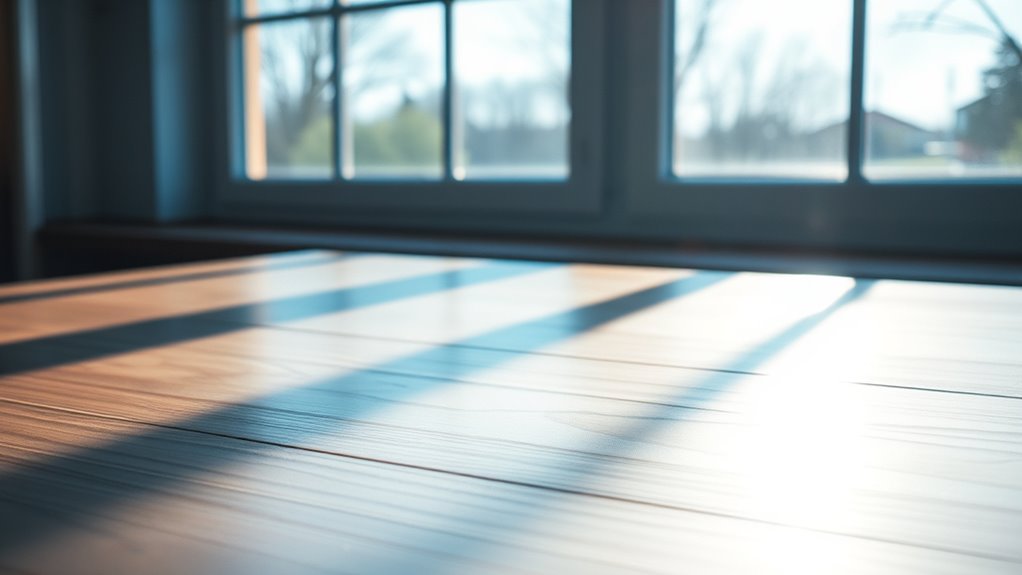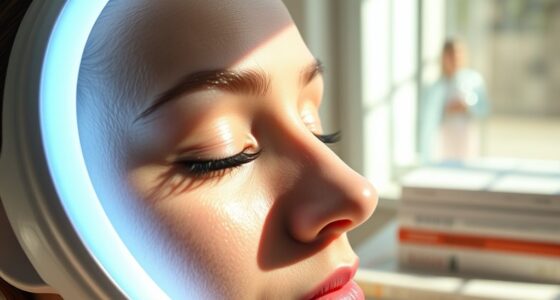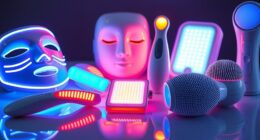Exposing yourself to blue light in the morning helps signal your internal clock to wake up, promoting alertness and setting a positive tone for the day. Natural blue light, like sunlight, is most effective at boosting mood, focus, and energy early on. Even a quick walk outside or opening your curtains can make a difference. Incorporating blue-enriched light into your routine clears the way for a more energized day—discovering more ways to optimize this process can lead to better mornings.
Key Takeaways
- Morning blue light exposure suppresses melatonin, signaling your internal clock to promote alertness.
- Natural light or light therapy boxes can effectively provide blue light to kickstart your day.
- Brief outdoor walks or opening curtains deliver essential blue spectrum light for better wakefulness.
- Proper morning blue light exposure enhances mood, focus, and energy levels throughout the day.
- Timing and environment lighting play crucial roles in regulating your circadian rhythm for a clearer day.

Blue light in the morning plays a crucial role in regulating your body’s internal clock, helping you wake up feeling more alert and energized. When you’re exposed to natural blue light early in the day, it signals your brain that it’s time to be awake, suppresses melatonin, and kickstarts your circadian rhythm. This process doesn’t just influence your wakefulness; it also impacts your mood, focus, and overall energy levels throughout the day. If you start your mornings with minimal exposure to blue light—say, on cloudy days or by staying indoors—you might find yourself feeling sluggish or less motivated. That’s because your internal clock isn’t receiving the cues it needs to set itself properly, which can throw off your sleep patterns and leave you feeling groggy.
Getting enough blue light in the morning doesn’t mean you have to spend hours outside, though. A quick walk outside or even opening your curtains can make a difference. Natural light contains a broad spectrum of wavelengths, including blue light, and is the most effective way to signal your brain that it’s daytime. If you’re short on time or live in a place with limited sunlight, consider using a light therapy box designed specifically to mimic natural sunlight. These devices emit a controlled amount of blue-enriched light, which can help reset your internal clock and improve your morning alertness. Just a 20-minute session can have noticeable benefits, especially during the darker months when sunlight is scarce.
A quick walk outside or a 20-minute light therapy session can boost your morning alertness.
You should also be mindful of your screen time in the morning. Many digital devices emit blue light, which can interfere with your circadian rhythm if you’re exposed to it late in the evening. But in the morning, a limited amount of screen time—like checking your phone or computer—can actually be beneficial if it’s done in conjunction with natural light exposure. Just avoid prolonged exposure to screens right before bed, as it can delay your sleep onset and disrupt your sleep quality. Instead, aim to get your blue light boost early, then wind down without screens as the day progresses.
Additionally, understanding the importance of color temperature can help you optimize your lighting environment to better support your circadian rhythm and morning alertness. Incorporating blue light exposure into your morning routine is a simple yet powerful way to set a positive tone for the day. It helps you feel more awake, enhances your concentration, and can even improve your mood. By consciously seeking out natural light or using a light therapy device, you give your body the cues it needs to function effectively. The result is a clearer, more energized day that starts on the right foot, making it easier to stay focused and productive from the moment you wake up.
Frequently Asked Questions
Can Blue Light Exposure Improve Morning Alertness?
Yes, blue light exposure can improve your morning alertness. When you get blue light in the morning, it helps regulate your circadian rhythm by suppressing melatonin, the sleep hormone. This makes you feel more awake and alert. You should try to get natural blue light from sunlight or use a light therapy box. Just be mindful not to overdo it, especially late in the day, to avoid disrupting sleep.
Does Blue Light Affect Melatonin Production Differently in Various Ages?
Yes, blue light affects melatonin production differently across ages. In children and teenagers, your melatonin suppression is more sensitive, meaning blue light can markedly delay sleep onset. As you age, your sensitivity decreases, so older adults experience less impact on melatonin. You should be mindful of blue light exposure, especially in the evening, to maintain healthy sleep patterns regardless of your age.
Are There Specific Blue Light Wavelengths More Beneficial in the Morning?
Yes, blue light wavelengths around 480 nanometers are most beneficial in the morning. They help suppress melatonin production and boost alertness effectively. You should aim to get exposure to these wavelengths early in the day, ideally through natural sunlight or specialized light therapy devices. This approach can enhance your mood, improve focus, and set a healthy circadian rhythm, leading to a more energized and productive day.
How Does Blue Light Impact Mood and Mental Health?
Imagine waking up feeling energized and positive after morning blue light exposure. Blue light boosts your mood by regulating your circadian rhythm and increasing serotonin levels. It helps combat depression and anxiety, especially during darker months. For example, a person using blue light therapy reports improved mental clarity and happiness. Regular morning blue light exposure can lift your spirits and support overall mental health, making your days brighter and more balanced.
Can Blue Light Therapy Replace Natural Morning Sunlight?
Blue light therapy can supplement but not fully replace natural morning sunlight. While it helps improve mood, regulate your circadian rhythm, and boost alertness, natural sunlight provides additional benefits like vitamin D synthesis and broader spectrum light that therapy devices can’t replicate. For ideal mental health, aim to get some outdoor sunlight daily, using blue light therapy as a helpful addition, especially during cloudy days or winter months.
Conclusion
Embracing blue light in the morning is like hitting the reset button for your day. It helps wake up your mind and sets a positive tone, making everything feel brighter and more manageable. Just as the sun chases away the night, morning blue light clears the fog and energizes you. So, step outside or open those curtains—you’re planting the seeds for a clearer, more vibrant day ahead. Let blue light be your morning’s guiding star!









